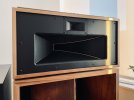Tovarich007
Senior Member
- Joined
- Jan 31, 2021
- Messages
- 304
- Likes
- 437
I didn't know speakers were made back in 1772. That's great news, history of technics revisited
As for the speakers, I totally dislike the biggest- it looks definitely terrible to my taste- but I'm not sure of my own feeling for the little egg shaped one : do I find it awful or cute ? awfully cute or cutely awful ? that's a dilemma...
But I admit the flowers are nice. I guess they also calm down the nerves when listening heavy metal at high volume.
What is this brand ?
Last edited:


